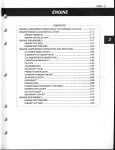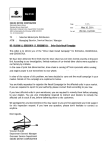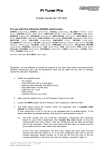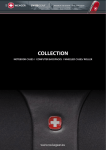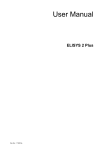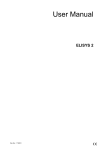Download Suzuki V-Strom DL1000 Clutch Basket Removal and Re
Transcript
Suzuki V-Strom DL1000 Clutch Basket Removal and Re-fitting Also suitable for use with the Suzuki SV1000 – very similar. Downloaded from Original pictures by Daniel M. O'Brien, 2003 Converted to PowerPoint by Janice Clanfield, 2008, Updated and further pictures added by John Sykes Sharealike or svman on the forums 2012. Introduction Some of the following slides were first put together by Daniel M. O'Brien and later converted to PowerPoint by Janice Clanfield. I would like to thank them and hope they are happy with the changes. Since their launch in 2002 right up to 2009, owners have found the clutch baskets in the Suzuki V-Strom DL1000 to cause a harsh engine vibration while riding. It became known as the “chudder” – part shudder and part chatter. There was also some unpleasant noise at idle. It was thought the only cure was a new clutch basket or to fit the later Suzuki SV1000 basket. By 2009 there was evidence that neither of these was a reliable cure as the vibrations all too often returned. Since 2009 many owners have been removing and re-fitting their bikes original clutch basket after they had been re-engineered. Over the years some of these owners either asked for clarification or gave feedback after following the original slides. I began to revise and included new slides as required responding to the feedback. Now in late 2012, the fully revised slides have been available for six months, so I am looking to make them available to all for download. Hope they prove as helpful in taking owners through the job as the originals. Always glad of feedback to improve them further. Thank you to all who contributed. Sharealike aka Svman. John Sykes [email protected] The centre stand or a paddock/race stand is good. Straight up position is best for draining fluids. This is the clutch side of the engine case, where the sight glass is. Drain the oil while hot, the chin guard will be removed after draining the oil Remove the nose piece, and right side fairing, the engine guards keep the fairing from coming off easily, so best remove the black piece from the fairing first. Not required for SV. And leave the black piece in place, no need to remove it, note the Radiator Cap, don't remove it yet! Body parts removed, fairing, chin guard, and nose piece Ready to drain the Coolant. Check that the Engine has cooled as the water is under pressure an will scald. Check the engine has cooled. Loosen slightly to release pressure. Then remove the coolant drain plug. Choice of two. Small aluminum sealing washer might stick on plug or cover. Do not lose. Will drip a little. Place a clean container under it, remove the radiator cap slowly and use that to regulate the flow as it drains. Remove the radiator hoses from the water pump, a 1/4" hand driver works well with a 6mm socket, two hoses need it, other is simple squeeze clamp, note the pan below to catch incidental coolant and oil (don't tell my spouse, but it’s her turkey pan) 3 2 1 The three connections with their hoses removed. 1 – Water pump, 2 – Small bypass hose, 3 – Engine breather Need to remove right hand foot rest - hexagon bits are good Peg and brake pedal come off as unit, twist out of the way The brake light switch spring comes off the brake pedal and can tuck up here out of the way A nice touch can be to use a syringe or towel to draw out water from these two water ways. Saves it falling into the clutch and sump when the clutch cover is lifted off. Remove 5 water pump housing bolts. Pull off the housing. Sealing "O" ring might be in the cover or stuck on the pump as here (not really an O is it?) Note the impeller. Try not to turn this when the cover is off. Makes fitting easier later. Now remove all the perimeter bolts from the clutch cover. Then it pulls off easy. If stuck check all bolts are out. There are three ears on the cover perimeter to lever behind to crack the initial seal if required. Should not need any force. There will be some extra oil and water drainage, thus the pan Remove the clutch pressure plate springs, loosen all first, then remove opposite bolts, when down to last two loosen both equally until they come out, so you can remove the pressure plate The pressure plate removed leaving the clutch plates. Can be carefully removed one by one. Remove the clutch rod top hat from the middle. The bearing and it’s thrust washer are likely stuck to the inside of the pressure plate. Removed clutch plates (drive and driven) stacked in order on the pressure plate, note the clutch rod top hat, thrust bearing, and thrust washer. Keep all from dust and dirt. Do not lose the disc spring and its seat shown inset. All that is left is the inner hub that drives the transmission and the clutch basket that is driven by the engine, note the big nut in the center (30mm or 1 3/16") This nut holds the hub and basket on the gearbox shaft. Straighten the soft locking ring on the nut. Perhaps tap in an old screwdriver blade? Last bit sometimes straightens its self as the nut is undone. DL1000 and SV1000 specific clutch hub and basket holding tool. Holding the hub with a universal clutch hub tool, use socket and... Air impact wrench can make short work of the nut. Normal 30mm socket and extension bar with a tube for greater leverage also works well. Hub and washers slide off leaving the clutch basket. This also just slides off exposing The bearing the basket runs on (might try to come off with the basket and drop). Below is the oil pump gear driven by the clutch basket. TAKE CARE. This relatively delicate gear has to be aligned when putting the clutch basket back on its shaft. Note the screen designed to trap major oil pollutants so they don't flow through the system. There’s a round recess in the case immediately below this. Catches larger bits of metal that drop back off the screen. Good place to feel if your basket has broken springs or was once shimmed with washers that have broken up. The oil pump drive gear is removed from the clutch basket with heavy clip ring pliers (note the inner hub next to it) Remove the spring cir-clip, oil pump drive gear and steel dowel. Keep safe for fitting to the returned basket. Watch for the dowel – easily falls out and rolls away As you go along, keep all related fasteners together in bags, fairing and body parts, clutch cover, and clutch pressure springs For the installation it can help to use the Service Manual. Particularly if the original order the clutch plates came out in has been lost. 1 PARTS REQUIRED Essentials BIKES ORIGINAL MODIFIED CLUTCH BASKET – Also known as GEAR ASSY, PRIMARY DRIVEN (but only if buying new from Suzuki) NEW GASKET 11482-06G00 or 11482-06G10 GASKET,CLUTCH COVER – Just which depends on bike year And the nice to have for a quality job - Suzuki suggested but can be used again without problems. 17435-02F00 O-RING,WATER PUMP 09159-24010 NUT 09164-24006 WASHER CLUTCH SLEEVE Detail of a re-engineered clutch basket. Note the new bronze bearing in the middle. Gear side of basket (back) will have three hexagon head setscrews. Please don’t try to dis-assemble. Something will break before they come out. Original Suzuki baskets do not have these. Keep the needle roller bearing and it’s sleeve to one side. They are used to fit the modified basket when it returns. Essential to pack well if sending off for modification. Rolled spacer in the middle keeps the delicate fingers well away from the top of the box. Similar required between box sides and body of basket. Minimum packing shown here. Dense polystyrene foam blocks cut from electrical equipment packaging also work well. This is where the fitting of the basket begins First ensure this washer is in place on the shaft. Chamfered side towards the bearing. Take the clutch hub sleeve, clean it off well, then lubricate the shaft and the inside of the sleeve with oil, slip it on. Note - new baskets come with a new matched sleeve. Use your baskets original if fitting a modified basket. Slide the original needle roller bearing over the sleeve and lubricate it well Install the old oil pump drive gear, drive dowel, and snap ring on the clutch basket - Check this is fitted for you if left on a basket that’s just returned after modification. Gently slide the basket onto the bearing and wiggle it back and forth to just engage the drive gears. Do not try to push it on all the way just yet - THEN Wiggle the oil pump shaft gear so that it engages with the gear on the back of the basket. Only then is it safe to gently slide the basket all the way home. Slip on the other thrust washer, and then the inner hub Slip on the flat washer and the special convex washer, note the orientation of the convex washer Screw on the new clutch hub nut DL1000 and SV1000 specific clutch hub and basket holding tool. Tighten hub nut with torque wrench to 108.5 ft-lbs, you will need the clutch hub holding tool again Next with chisel and hammer, make a detent on the clutch hub nut. Punch is better than chisel. Close up of the clutch hub nut. Better to use a punch. Split like this can open and the chip can break off. Here’s a clear view of the Clutch Hub without the basket or any Clutch plates in the way. First fit the damper spring SEAT – This is the slightly thicker of the two Large diameter steel rings. Sometimes sticks to the hub so owners never realised it was there Second fit the DAMPER SPRING. Note it has a dished cross section The concave side faces out and towards you. Or think of this as the smaller diameter goes on first. Larger diameter last and facing you. These rings damp the clutch take up when setting off. Get them wrong and the clutch can bite later feeling quite abrupt at take off. Put the drive and driven plates back in the order they came out. If mixed up then consult the manual and take measurements to determine which plate goes where. The friction plate with the larger bore in the middle is first in. Has that larger bore to make room for the damper spring and set in previous slide. Fuzzy picture – Just the LAST friction plate goes into OTHER slots. Take care – some have put the last two plates in these separate slots by mistake. The clutch will slip and not drive the bike after the job – frustration is you can see this looking down the oil filler hole on the clutch cover. Oil & water drain and cover off to fix Reinstall clutch push rod top hat, oiled thrust bearing and thrust washer Reinstall pressure plate. Press on firmly by hand while rocking back and forward a little. Check it touches the last fiction plate. It will feel to drag as you press. You are pushing the clutch fluid back up to the reservoir so be patient. Correct - Rotate the pressure plate a little on the hub to ensure the splines engage – no clutch plates or basket here for clarity Wrong - The clutch will not drive the bike after assembly if you fit the pressure springs with the pressure plate out of line - no clutch plates or basket here for clarity Keep the pressure on with your hand while at least three springs are hand tightened. Tighten them down in a diagonal fashion, torque to spec. All done. Pressure spring bolts torque and then checked again? – Now pull the clutch lever a few times. Check it feels as it did before and watch the pressure plate lift away from the plates and clamp them back together as you release the lever. Install the new gasket - Pay attention to the sealing faces round the two water ways. Note the slot in the middle of this gear drives the water pump.... Drive tab on the water pump impellor needs to be in the same position as the slot in the drive gear. Turn the impeller to get them in line. A gentle wiggle of the impellor might help if the cover does not go right up to the engine case first time. Put the clutch cover back on, aligning everything including the water pump impeller. Should slide on easy by hand and trap the gasket all the way around. You can hit it with the heel of your palm. It must fit flat before putting in the bolts Fit new or check the "O" ring in the water pump cover, manual says to apply a little grease to the O-ring. Sort out all the bolts and put them into the holes accordingly, hint: the three longest go into the water pump housing, torque it all down by slowly tightening opposite bolts a little at a time, torque to specifications, go slow! Now put the three hoses back in place Install the foot rest Refill crankcase with favorite oil Replace which ever of the coolant drain plugs were used. Check the sealing washer is there and in good condition. Re use the drained coolant if you know its still good, and use premixed coolant to top off. Follow service manual for clearing air in the coolant system, keep topping off. May need several starts, bike on side stand, heat/cool cycles, etc, to clear the air. May still suck coolant out of the overflow tank over the next few days The "big-o" screw driver handle can be used to tap the thermostat housing on the opposite side while the engine was running to dislodge any air bubbles. Button everything up, right side fairing, nose piece, AND YOU ARE DONE! I hope you found these slides helpful. Feedback to John. sharealike/svman [email protected] Downloaded from








































































